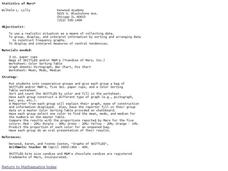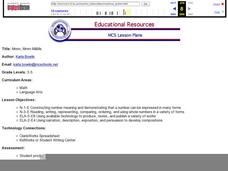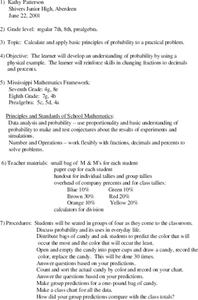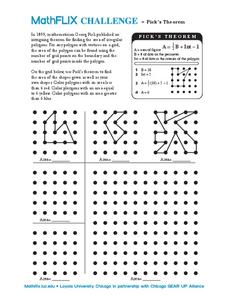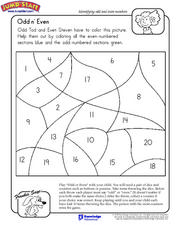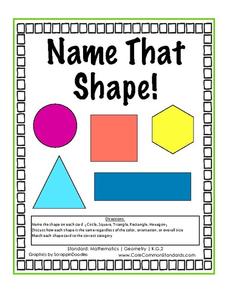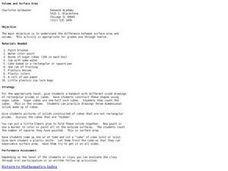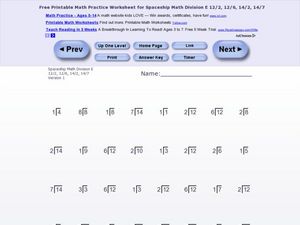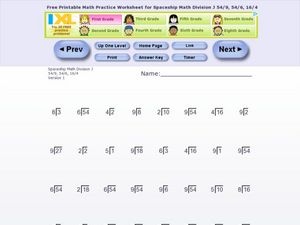Curated OER
Let's Color
In this reading colors learning exercise, learners read the description for the number and color of each item. Students then color the correct number of objects for each set.
Curated OER
Symmetry Using Polygons
Working on symmetry in your class? If so, this worksheet might be for you. Learners observe different triangles and quadrilaterals, determine which are symmetrical, draw in the lines of symmetry, and color the symmetrical shapes. In...
Curated OER
Statistics of Mars
Young scholars explore the concept of central tendencies. In this central tendencies lesson, students sort M&M's or Skittles based on color. Young scholars graph their results. Students find the mean, median, and mode of their data.
Curated OER
Mmm, Mmm, M&M's
Here is another version of the classic M&M math lesson. In this one, upper graders utilize the ClarisWorks Spreadsheet program in order to document the data they come up with from their bags of M&M's. After making their initial...
Curated OER
Probability using M & M's
Using M & M's candies, young statisticians predict the color distribution in a packet of candies and test their predictions against their group and the larger class. A review of converting between fractions, decimals, and percents...
Curated OER
Pick's Theorem
In this Pick's Theorem worksheet, students solve and graph 6 different problems that include using Pick's Theorem to solve. First, they use Pick's Theorem to determine the area of the shapes given as well as their own shapes drawn. Then,...
Curated OER
Perimeter All Around
Students explore perimeter and area of regular and irregular polygons. They experiment with color squares and create different arrangements using the same number squares. Then they compare the area and perimeter measurements of each.
Curated OER
Odd n' Even
For this odd and even worksheet, learners color the odd and even sections of the pictures different colors. Students color 20 sections total.
Curated OER
Froot Loops to the Max - 1
Middle schoolers complete and solve five questions related to a box of Froot Loops cereal. First, they determine how many of each color of Froot Loops and which color has the greatest and least frequency. Then, pupils write the fraction...
Curated OER
Data With Candy
Students, while utilizing the classroom and the computer lab with a bag of colored candy, gather and interpret data, calculate averages and draw conclusions and draw a bar graph. They estimate how many candies are in the bag, what...
Curated OER
Graphing
In this graphing worksheet, students solve and graph 10 different problems that include determining various coordinates and the slope. First, they use the table to write the x and y coordinates for each point on the graphs. Then,...
Curated OER
Introduction to Equivalent Fractions
Explore equivalent fractions! Youngters measure the crown of their head with adding tape labeled with various fractions and fractional parts, and compare strips to notice numerical relationships. They fold adding tape in half and color...
Curated OER
Halves And Fourths
Young learners start out by going to the board to draw lines through shapes to identify halves. Then they are given a square of paper and are directed to fold the paper into halves and then into fourths. They color the halves...
Curated OER
Equivalent Fractions
Introduce elementary young scholars, grades 3-5 to the concept of equivalent fractions. Each student folds a paper in half and color one of the equal parts of the paper. They use this paper to define numerator, denominator and the idea...
Curated OER
Count the Dots on Each Die
Kindergarteners use the dice reproduced on this activity to demonstrate their understanding of concepts of addition and missing numbers. After counting the dots on each die, young mathematicians write the number below each picture. They...
Curated OER
Name That Shape
It can be so much fun to learn about new shapes! Kindergartners are shown a series of different shapes; each one is a different color, size, or orientation. They look at the shapes and discuss that no matter their color or size, a square...
Curated OER
Volume and Surface Area, A Sweet Activity
Geometry.... sweet! Using sugar cubes, learners build rectangular prisms of different sizes and shapes. They glue them together and assess volume. Then they color the outer sides to visualize and compute surface area. To make a visceral...
DK Publishing
The Same
Which animals are the same? Youngsters draw lines connecting pictures of farm animals to their identical counterparts. They see a sheep, chick, goat, pig, and cow; the cow is done for them. Once they finish, scholars draw and color...
Curated OER
N is for Nest
In this early childhood letter N printing practice worksheet, pupils trace the uppercase and lowercase letters and then practice writing them on their own. Students also count the number of eggs in the nest and color it.
Curated OER
W is for Window
In this early childhood letter W printing practice instructional activity, students trace the uppercase and lowercase letters and then practice writing them on their own. Students also color the castle and count the number of windows on...
Mathed Up!
3-D Pythagoras
Apply the Pythagorean Theorem in three-dimensional shapes. Young mathematicians watch a video that takes them through several examples of using the Pythagorean Theorem to solve problems involving lengths in three-dimensional figures. A...
Curated OER
Spaceship math Multiplication 1-12
For this multiplication worksheet, students solve 40 problems where they find the product where the factors are the numbers 1 through 12. Space is provided at the bottom of the page to record a goal, the number of problems complete and...
Curated OER
Divide By One-Digit Numbers
For this finding the quotients worksheet, students divide one-digit and two-digit numbers by one-digit numbers with no remainders. Students solve 40 problems.
Curated OER
Divide Two-Digits by One-Digit 1
In this finding the quotients worksheet, 3rd graders divide two-digit numbers by one-digit numbers with no remainders. Students solve 40 problems.




